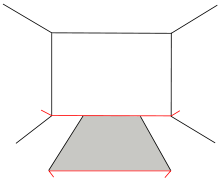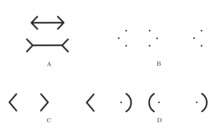Müller-Lyer illusion

The Müller-Lyer illusion is an optical illusion consisting of a stylized arrow. When viewers are asked to place a mark on the figure at the midpoint, they invariably place it more towards the "tail" end. The illusion was devised by Franz Carl Müller-Lyer (1857–1916), a German sociologist, in 1889.[1][2][3]
A variation of the same effect (and the most common form in which it is seen today) consists of a set of arrow-like figures. Straight line segments of equal length comprise the "shafts" of the arrows, while shorter line segments (called the fins) protrude from the ends of the shaft. The fins can point inwards to form an arrow "head" or outwards to form an arrow "tail". The line segment forming the shaft of the arrow with two tails is perceived to be longer than that forming the shaft of the arrow with two heads.
Variation in perception
Research has shown that perception of the Müller-Lyer illusion can vary.
Around the turn of the 20th century, W. H. R. Rivers had noted that natives of the Australian Murray Island were less susceptible to the Müller-Lyer illusion.[4] Rivers suggested that this difference may be due to Europeans living in more rectilinear environments. Similar results were also observed by John W. Berry in his work on Inuit, urban Scots, and the Temne people in the 1960s. .[5]
Segall, Campbell and Herskovitz[6] in 1963 compared susceptibility to four different visual illusions in three population samples of Caucasians, twelve of Africans, and one from the Philippines. For the Müller-Lyer illusion, the mean fractional misperception of the length of the line segments varied from 1.4% to 20.3%. The three European-derived samples were the three most susceptible samples, while the San foragers of the Kalahari desert were the least susceptible. It should be done very systematically.
In 1965, following a debate between Donald T. Campbell and Melville J. Herskovits on whether culture can influence such basic aspects of perception such as the length of a line, they suggested that their student Marshall Segall investigate the problem. In their definitive paper of 1966, they investigated seventeen cultures and showed that people in different cultures differ substantially on how they experience the Müller-Lyer stimuli. They write[7]
- European and American city dwellers have a much higher percentage of rectangularity in their environments than non-Europeans and so are more susceptible to that illusion.
They also used the word "carpentered" for the environments that Europeans mostly live in - characterized by straight lines, right angles, and square corners.
These conclusions were challenged in later work by Gustav Jahoda, who tested members of an African tribe living in a traditional rural environment vs. members of same group living in African cities. Here, no significant difference in susceptibility to the M-L illusion was found. Subsequent work by Jahoda suggested that retinal pigmentation may have a role in the differing perceptions on this illusion,[8] and this was verified later by Pollack (1970). It is believed now that not "carpenteredness", but the density of pigmentation in the eye is related to susceptibility to the M-L illusion. Dark-skinned people often have denser eye pigmentation.[9]
A study published in 1973, conducted with fives groups of Zambians and on one of Americans by Stewart,[10] found no evidence of relation between the density pigmentation in the eye and the susceptibility to the M-L illusion, but found evidence of the influence of the "carpentered world" hypothesis as well as gender differences: women are less susceptible to the Müller-Lyer illusion and to the Sander illusion, as well.
A study conducted in 1977 by Pollnac[11] "provides a strong test of the environmental hypothesis by interrelating years of experience as a fisherman with susceptibility to the vertical-horizontal illusion among small-scale fishermen in the Gulf of Nicoya, Costa Rica". -(chatrath Radha)
A later study was conducted in 1978 by Ahluwalia[12] on children and young adults from Zambia. Subjects from rural areas were compared with subjects from urban areas. The subjects from urban areas were shown to be considerably more susceptible to the illusion, as were younger subjects. While this by no means confirms the carpentered world hypothesis as such, it provides evidence that differences in the environment can create differences in the perception of the Müller-Lyer illusion, even within a given culture. Experiments have been reported[13] suggesting that pigeons perceive the standard Müller-Lyer illusion, but not the reversed. Experiments on parrots have also been reported with similar results.[14]
Recent findings suggest that military men have pronounced personality traits which are correlated with the misperception magnitude of the Müller-Lyer illusion.[15]
The perspective explanation

One possible explanation, given by Richard Gregory,[16] states that the Müller-Lyer illusion occurs because the visual system processes that judge depth and distance assume in general that the "angles in" configuration corresponds to an object which is closer, and the "angles out" configuration corresponds to an object which is far away. Basically, there seems to be a simple heuristic that takes those configurations as 90° angles. This heuristic speeds up the interpretation process, but gives rise to many optical illusions in unusual scenes. A recent report[17] by Catherine Howe and Dale Purves summarizes current thinking on Gregory's ideas:
Although Gregory's intuition about the empirical significance of the Müller-Lyer stimulus points in the right general direction (i.e., an explanation based on past experience with the sources of such stimuli), convex and concave corners contribute little if anything to the Müller-Lyer effect.
Neural nets in the visual system of human beings learn how to make a very efficient interpretation of 3D scenes. That is why when somebody goes away from us, we do not perceive them as getting shorter. And when we stretch one arm and look at the two hands we do not perceive one hand smaller than the other. Visual illusions are sometimes held to show us that what we see is an image created in our brain. Our brain supposedly projects the image of the smaller hand to its correct distance in our internal 3D model. This is what is called the size constancy mechanism hypothesis.
In the Müller-Lyer illusion, the visual system would in this explanation detect the depth cues, which are usually associated with 3D scenes, and incorrectly decide it is a 3D drawing. Then the size constancy mechanism would make us see an erroneous length of the object which, for a true perspective drawing, would be farther away.
In the perspective drawing in the figure, we see that in usual scenes the heuristic works quite well. The width of the rug should obviously be considered shorter than the length of the wall in the back.
The centroid explanation

.gif)
According to the so-called centroid hypothesis,[18] judgments of distance between visual objects are strongly affected by the neural computation of centers-of-masses (centroids) of the luminance profiles of the objects (i.e., the position of centroid of an image determines its perceived location). As suggested by Morgan et al. [19], visual procedure of centroid extraction is causally related to a certain integration of neural activations (spatial pooling of the positional signals) evoked by the neighboring object parts. Though the integration reduces the ability of the visual system to determine accurately the mutual position of image elements (i.e., coarsens the positional acuity), such pooling seems to be quite biologically substantiated since it allows fast and reliable assessment of the location of the visual object as whole, irrespective of its size, the shape complexity, and illumination conditions. Concerning the Müller-Lyer and similar illusions, the pattern of neural excitation evoked by contextual flank (e.g., the Müller-Lyer wings themselves) overlaps with that caused by the stimulus terminator (e.g., the wings apex), thereby leading (due to the shift of the centroid of summed excitation) to its perceptual displacement (these positional changes are apparent in Dynamic Müller-Lyer Illusion by Gianni A. Sarcone, particularly with gaze fixation on any of the terminators). The crucial point in the centroid explanation regarding the positional shifts of the stimulus terminators in direction of the centers-of-masses of contextual flanks was confirmed in psychophysical examination of illusory figures with rotating distractors [20]. The relative displacement of all stimulus terminators leads to misjudgment of distances between them; that is, the illusion occurs as a side effect due to necessarily low spatial resolution of the neural mechanism of assessment of the relative location of the visual objects. Unlike most other approaches, the centroid explanation is based on a relatively small set of assumptions and is capable of making quantitative predictions that can be immediately and purposefully tested in experiments with a wide variety of stimuli modifications. This quantitative approach offers not only some general trends, but also reveals a certain "fine structure" of the illusion magnitude changes [21], what is still unattainable for most of other widely accepted explanations of illusions of extent of the Müller-Lyer type.

References
- ↑ Müller-Lyer, FC (1889), "Optische Urteilstäuschungen"; Archiv für Physiologie Suppl. 263–270.
- ↑ Brentano, F (1892), "Über ein optisches Paradoxen", Zeitschrift für Psychologie, 3:349–358.
- ↑ Müller-Lyer, FC (1894), "Über Kontrast und Konfluxion", Zeitschrift für Psychologie, IX p 1 / X p 421.
- ↑ Rivers 1901: The measurement of visual illusion Rep. Brit. Ass., p. 818
- ↑ Berry, John W. (1968), "Ecology, perceptual development and the Müller-Lyer illusion", British Journal of Psychology, 59 (3): 205–210, doi:10.1111/j.2044-8295.1968.tb01134.x
- ↑ Cultural Differences in the Perception of Geometric Illusions Author(s): Marshall H. Segall, Donald T. Campbell, Melville J. Herskovits Source: Science, New Series, Vol. 139, No. 3556 (February 22, 1963), pp. 769-771
- ↑ http://psycnet.apa.org/psycinfo/1967-05876-000
- ↑ Jahoda, Gustav (1971). "Retinal pigmentation, illusion susceptibility and space perception". International Journal of Psychology. 6 (3). pp. 199–207. doi:10.1080/00207597108246683.
- ↑ Cole, Michael; Barbara Means; Comparative Studies of How People Think: An Introduction, 1986.
- ↑ Tests of the “Carpentered World” Hypothesis by Race and Environnement in America and Zambia1. International Journal of Psychology, 8(2), 83–94. Stewart, V. M. (1973). http://doi.org/10.1080/00207597308247065
- ↑ Illusion Susceptibility and Adaptation to the Marine Environment Is the Carpentered World Hypothesis Seaworthy? Pollnac, R. B. (1977), Journal of Cross-Cultural Psychology, 8(4), 425–434. http://doi.org/10.1177/002202217784005
- ↑ An intra-cultural investigation of susceptibility to "perspective" and "non-perspective" spatial illusions, Br. J. of Psychol., 1978, 69, 233-241
- ↑ Nakamura, Noriyuki; et al. "Perception of the Standard and the Reversed Müller-Lyer Figures in Pigeons (Columba livia) and Humans (Homo sapiens)". Journal of Comparative Psychology. 2006 August Vol 120(3) 252-261. Retrieved 2008-07-25.
- ↑ Pepperberg, Irene; et al. "The Müller-Lyer illusion is processed by a Grey Parrot (Psittacus erithacus)" (PDF). Perception 37:765-781. Retrieved 2011-07-30.
- ↑ Zhang, Yingchun; Liu, Jing; Wang, Yongli; Huang, Jingyi; Wei, Lili; Zhang, Bingren; Wang, Wei; Chen, Wei (2017-01-01). "Personality traits and perception of Müller-Lyer illusion in male chinese military soldiers and university students". Translational Neuroscience. 8 (1). ISSN 2081-6936. doi:10.1515/tnsci-2017-0004.
- ↑ Richard L. Gregory, Eye and Brain, McGraw Hill, 1966.
- ↑ The Müller-Lyer illusion explained by the statistics of image–source relationships Catherine Q. Howe and Dale Purves* PNAS January 25, 2005 vol. 102 no. 4 1234-1239
- ↑ Whitaker, D., McGraw, P. V., Pacey, I., Barrett, B. T. (1996). Centroid analysis predicts visual localization of first- and second-order stimuli. Vision Research, 36, 2957-2970.
- ↑ Morgan M.J., Hole G.J., & Glennerster A. (1990). Biases and sensitivities in geometrical illusions. Vision Research, 30, 1793−1810.
- ↑ Bulatov A., Bertulis A., Mickienė L., Surkys T., Bielevičius A. (2011) Contextual flanks' tilting and magnitude of illusion of extent. Vision Research 51(1), 58−64. https://doi.org/10.1016/j.visres.2010.09.033
- ↑ Bulatov A., Bulatova N., Surkys T., & Mickienė L . (2015) A quantitative analysis of illusion magnitude changes induced by rotation of contextual distractor. Acta Neurobiologiae Experimentalis, 75, 238−251. http://www.ane.pl/pdf/7520.pdf
External links
- Müller-Lyer Illusion
- Dynamic Müller-Lyer Illusion by Gianni A. Sarcone
- The Müller-Lyer illusion explained by the statistics of image–source relationships
- The misplaced illusion? The case of the Mueller-Lyer perceptual incongruity figure.
- NAKAMURA Noriyuki (Müller-Lyer Illusion in pigeons)
- The Muller-Lyer Illusion explained by Rochester Institute of Technology